
Wild West Yorkshire, Sunday 10 October 2010
previous | this month | next


 I'VE REALLY come to the Ribble Valley, Lancashire, to explore the countryside that Arthur Conan Doyle would have been familiar with during his schooldays at Stonyhurst College but I can't help seeing the woods, rivers and distant hills as a Lord of the Rings landscape. Tolkien regularly stayed at the guest house at the college during the 16 year period when he was writing his epic trilogy of the history of Middle Earth.
I'VE REALLY come to the Ribble Valley, Lancashire, to explore the countryside that Arthur Conan Doyle would have been familiar with during his schooldays at Stonyhurst College but I can't help seeing the woods, rivers and distant hills as a Lord of the Rings landscape. Tolkien regularly stayed at the guest house at the college during the 16 year period when he was writing his epic trilogy of the history of Middle Earth.
 We follow the little River Hodder to its confluence with the Ribble (left). You might think that I've strayed far from my 'Wild West Yorkshire' territory as we're less than 25 miles from the Irish Sea at Blackpool but the Hodder marks the historic boundary of the West Riding of Yorkshire.
We follow the little River Hodder to its confluence with the Ribble (left). You might think that I've strayed far from my 'Wild West Yorkshire' territory as we're less than 25 miles from the Irish Sea at Blackpool but the Hodder marks the historic boundary of the West Riding of Yorkshire.
The Ribble soon broadens as another, smaller river, the Calder, joins it. In Tolkien's - and Doyle's - time there was a ferry immediately downstream from the confluence with the Calder at Hacking Hall. The ferry and the ferryman's hut are on display in Clitheroe Museum.
It's one of those many details that has no direct bearing on the story that I'm researching but I've got it on my list to call at the museum because I'd be fascinated to see this relic of times gone by.
There's a possible Tolkien connection; it's been suggested that this was the inspiration for the Buckleberry Ferry which the Hobbits cross as they're pursued by The Black Riders in The Lord of the Rings.
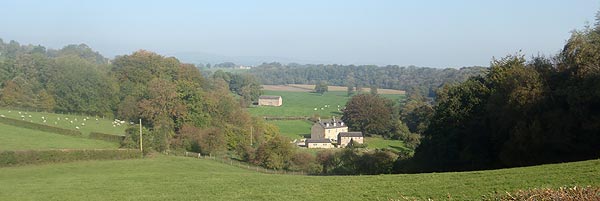

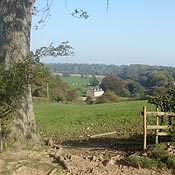 The Shire
The ShireThe Hodder Valley would be perfect for the Hobbit homeland of The Shire.
We take a break in a bus shelter that looks out over the homely-looking pastures of the Hodder valley to the blue-grey misty bulk of Pendle Hill which lies beyond like a beached whale (below).
In the valley there's a refreshing breeze but it stays sunny all day while Pendle retains its misty aura. Pendle is most famous for the witch trials of 1612 and that dark, magical association makes it a perfect stand-in for Tolkien's Misty Mountains.
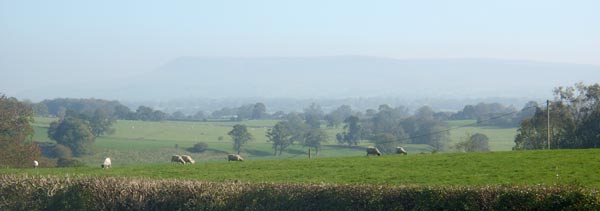

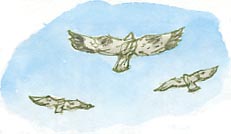 We heard a repeated high-pitched, agitated call and looked up to see a crow giving a buzzard a hard time by repeatedly diving down on it, causing the buzzard to take evasive action. The crow was outnumbered as there were three buzzards flying together but that wasn't going to stop it.
We heard a repeated high-pitched, agitated call and looked up to see a crow giving a buzzard a hard time by repeatedly diving down on it, causing the buzzard to take evasive action. The crow was outnumbered as there were three buzzards flying together but that wasn't going to stop it.
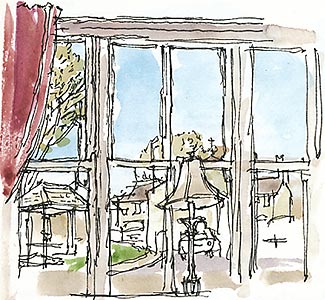 The Shireburn
The ShireburnTolkien's River Shirebourn share's its name with the Shireburn family who built Stonyhurst. We finish our walk with lunch at the Shireburn Arms in Hurst Green. You can appreciate how Hobbits might find themselves at home in the village as you climb up the south-facing slope from the Ribble; it would be a perfect location for Hobbit holes.
 As we started the walk, our first sight of the college was the Observatory (right), built in 1868. It replaced an earlier observatory of 1845 which is now used as a tea-rooms, open to the public in the summer.
As we started the walk, our first sight of the college was the Observatory (right), built in 1868. It replaced an earlier observatory of 1845 which is now used as a tea-rooms, open to the public in the summer.
 The corner Garden Pavillions were built by Sir Nicholas Shireburn in the late 17th century.
The corner Garden Pavillions were built by Sir Nicholas Shireburn in the late 17th century.

 Sir Nicholas was the last of the Shireburns and when the house passed to the Weld family in 1754 it fell into decay. Forty years later, as French Revolutionary forces advanced on Liège the house was put at the disposal of the Jesuit English College who were forced to flee from the town.
Sir Nicholas was the last of the Shireburns and when the house passed to the Weld family in 1754 it fell into decay. Forty years later, as French Revolutionary forces advanced on Liège the house was put at the disposal of the Jesuit English College who were forced to flee from the town.
It became a Catholic boarding school for boys. In addition to Tolkien and Conan Doyle its literary connections include the poet Gerald Manley Hopkins, who was a member of staff.
Tolkien's son Michael taught classics at the College and St Mary's Hall (a preparatory school) in the 1960s and 1970s.
Link: Trail leaflet In the footsteps of J R R Tolkien; map, directions
Richard Bell, illustrator
previous | this month | Wild West Yorkshire home page | next